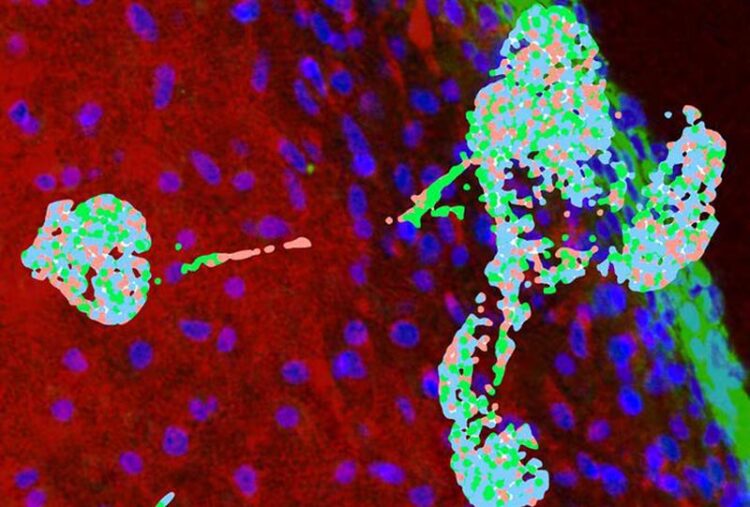New way to generate human cartilage discovered

This image shows a graph of gene expression patterns of organoids created in a University of Montana lab transitioning to become cells that form human cartilage. It’s overlaid on a picture of an organoid showing distinct outer and inner layers.
Courtesy of Mark Grimes
University of Montana researchers and their partners have found a new method to generate human cartilage of the head and neck.
Mark Grimes, a biology professor in UM’s Division of Biological Sciences, said they have induced stem cells to become the cell type that normally makes up human craniofacial cartilage. Stem cells can replicate themselves and also develop into different types of cells.
“The cells that normally give rise to this type of cartilage are called neural crest cells,” Grimes said. “We found a novel method for generating craniofacial organoids from neural crest cells.”
Organoids are a simplified, miniature version of an organ that mimic the architecture and gene expression of the organ. “Organoids are a good model for certain human tissues that we can study in ways that are not possible using tissue from human beings,” he said.
Grimes said there is a critical unmet need for new methods to regenerate human cartilage for the 230,000 children born annually in the U.S. with craniofacial defects. Growing cartilage in the laboratory also could lead to effective treatments to repair craniofacial cartilage damage due to injuries.
The researchers studied gene expression data at the RNA and protein level to reveal how cartilage cells arise from stem cells. They revealed that stem cells communicate in the early stages to become elastic cartilage, which makes up human ears.
To accomplish this, the team used extensive analysis of biological markers and machine-learning pattern-recognition techniques to understand the cell signaling pathways involved when cells differentiate into cartilage.
It is difficult to reconstruct natural features such as a person’s ears, nose or larynx with current plastic surgery techniques, and transplanted tissue is often rejected without immunosuppressants.
“To use patient-derived stem cells to generate craniofacial cartilage in the laboratory, you need to understand the human-specific differentiation mechanisms,” Grimes said. “Our aim is to develop a protocol for craniofacial cartilage generation for transplantation using human stem cells.”
The research was published in the journal iScience. Besides Grimes, contributing UM authors include Lauren Foltz, Nagashree Avabhrath and Jean-Marc Lanchy. Other authors are Bradly Peterson of Missoula’s Pathology Consultants of Western Montana and Tyler Levy, Anthony Possemato and Majd Ariss of Cell Signaling Technology of Danvers, Massachusetts.
Journal: iScience
Article Title: Craniofacial Chondrogenesis in Organoids from Human Stem Cell-Derived Neural Crest Cells
Article Publication Date: 28-Mar-2024
All latest news from the category: Life Sciences and Chemistry
Articles and reports from the Life Sciences and chemistry area deal with applied and basic research into modern biology, chemistry and human medicine.
Valuable information can be found on a range of life sciences fields including bacteriology, biochemistry, bionics, bioinformatics, biophysics, biotechnology, genetics, geobotany, human biology, marine biology, microbiology, molecular biology, cellular biology, zoology, bioinorganic chemistry, microchemistry and environmental chemistry.
Newest articles
Faster, more energy-efficient way to manufacture an industrially important chemical
Zirconium combined with silicon nitride enhances the conversion of propane — present in natural gas — needed to create in-demand plastic, polypropylene. Polypropylene is a common type of plastic found…

Energy planning in Ghana as a role model for the world
Improving the resilience of energy systems in the Global South. What criteria should we use to better plan for resilient energy systems? How do socio-economic, technical and climate change related…

Artificial blood vessels could improve heart bypass outcomes
Artificial blood vessels could improve heart bypass outcomes. 3D-printed blood vessels, which closely mimic the properties of human veins, could transform the treatment of cardiovascular diseases. Strong, flexible, gel-like tubes…




















